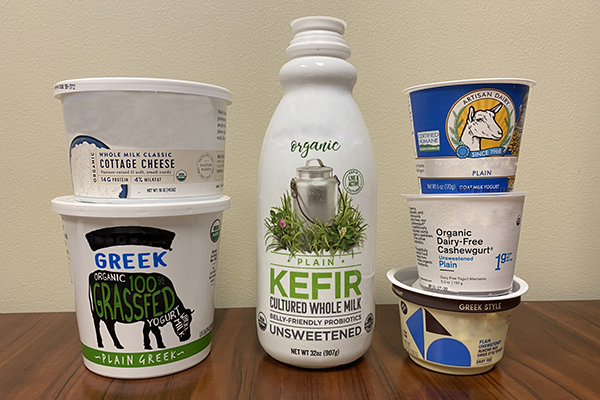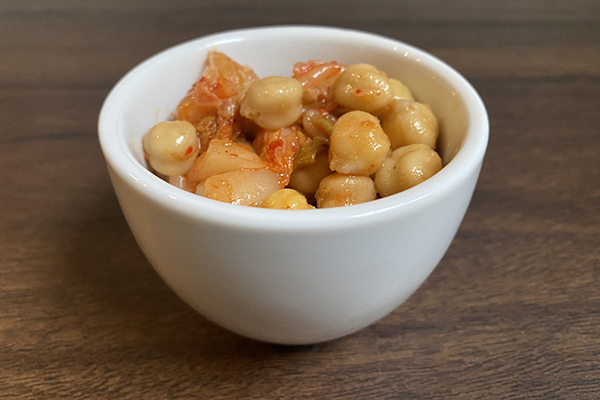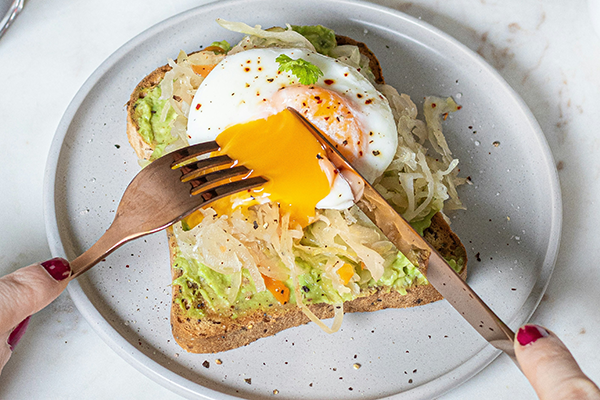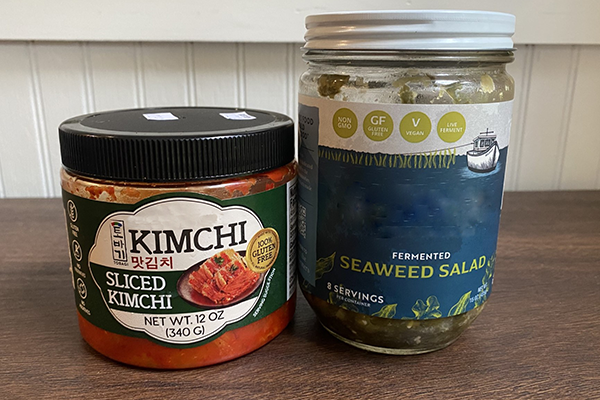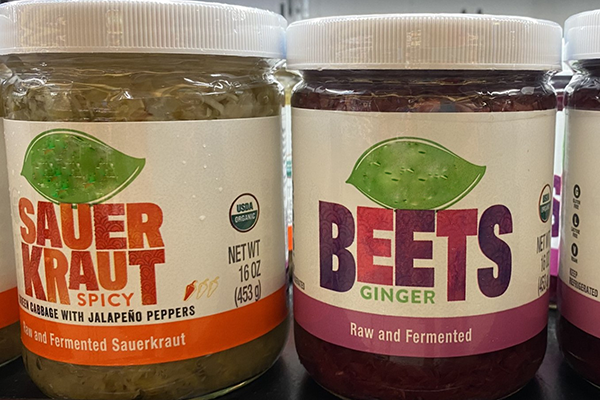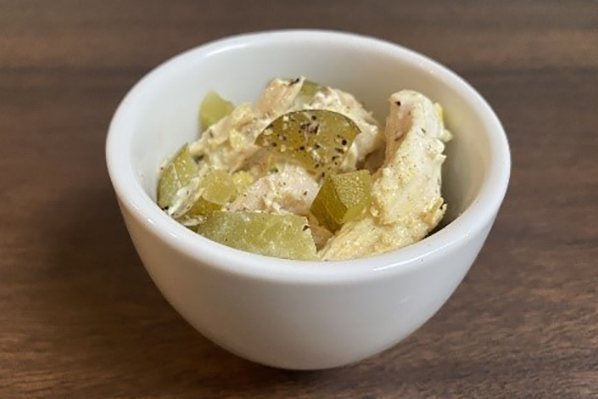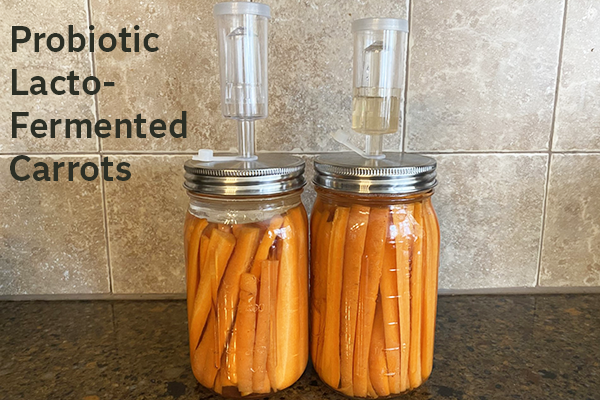I’m all for a good 2-for-1 deal, so if there’s a food I can use as a condiment to jazz up eggs, salads, beans, grain bowls, meat, fish and wraps while offering unique health-promoting properties, sign me up! Enter fermented foods — these functional foods that are created through controlled microbial growth have shown promise in thousands of scientific studies and reviews toward establishing a strong foundation for health beyond their famous gut balancing benefits.
Feed on fermented foods for a foundation for health. #saslife #fermentedfood Click To TweetRecent studies suggest that an eating pattern high in fermented foods steadily increases the diversity of microorganisms in the gut, decreases inflammatory markers and enhances our immune function. Optimizing our gut microbiomes with beneficial bacteria and their byproducts can also improve digestion, nutrient assimilation and gut barrier function and have triglyceride, cholesterol and blood sugar lowering effects. And to top it off, consuming fermented foods and probiotics to enhance the gut microbiome has been associated with reduced symptoms of depression and anxiety.
How can fermented foods possibly impact brain health? Certain bacteria, Bifidobacterium (B. longum, B. breve, and B. infantis) and Lactobacillus (Lb. helveticus , Lb. plantarum and Lb. rhamnosus), found in some fermented foods help to maintain levels of neuropeptide brain-derived neurotrophic factor (BDNF) and contribute to improved mental health and cognition, perhaps through BDNF and other neurotransmitter production. You read that right, bacteria can produce neurotransmitters that affect our brains! In fact, there’s a whole field of study related to the gut-brain axis.
Favorable Factors of Fermented Foods
Though supplementing with specific strains of probiotics can have therapeutic uses for certain health conditions, probiotics are just one piece of a much larger puzzle. Fermented foods are truly an ecosystem with a vast array of health-promoting components that shouldn’t be ignored. They are chock full of the following:
- Prebiotics - fiber and phytochemicals that beneficial microorganisms feed on. In our digestive tracts, prebiotics act as fertilizer and food that supports a healthy microbiome. Powerful prebiotics include inulin, oligosaccharides and arabinogalactans. A few foods that make the high prebiotic foods list include asparagus, banana, chicory, cocoa, dandelion greens, flaxseed, garlic, jicama, legumes, onion and whole grains. But really any food that can be fermented in a salt brine contains prebiotics which the probiotic bacteria thrive on.
- Probiotics - microorganisms that can have beneficial effects in or on your body. Fermented dairy and vegetables commonly contain strains of bacteria from the Lactobacillus and Bifidobacterium genera, and fermented teas and fruit (e.g., kombucha and wine) often host the probiotic yeast Saccharomyces. Amounts and strains of these different microorganisms vary with the type of fermented food and the conditions in which they are fermented.
- Bacteriophages (phages) - viruses that only infect bacteria and seem to survive the fermentation process. Phages are actually the most prevalent viruses in the human body. Stay tuned for future research to fully illuminate the magnitude of their impact. It is predicted that phages play a significant role in the maintenance of human health through processes such as transferring genes throughout the gut microbiome. Phages also seem to have a beneficial role as biocontrol agents, preventing the overgrowth of potentially harmful bacteria.
- Postbiotics - products created by probiotics and gut microorganisms through their metabolic processes. Beneficial postbiotics include, but are not limited to, vitamin K2, B vitamins, short-chain fatty acids, amino acids, peptides and even neurotransmitters. Postbiotics create an environment that supports the balance of the microbiome and play a vital role in managing our overall health — from gut to immune to brain. Though postbiotic research is still new, there is increasing evidence that postbiotics have the potential to strengthen the gut barrier, reduce inflammation, keep gut pathogens in check and modulate immune responses.
Aim for a Variety
Fermented foods naturally contain gut-supporting prebiotics, probiotics, bacteriophages and postbiotics that can’t be found in a pure probiotic supplement. The unique blends of these bioactive compounds in each fermented food and each person's distinct combination of microorganisms residing in their colons make it difficult to offer a universal recommendation for amounts or types to eat to guarantee meaningful health benefits.
As with so many things in life — our community, our genome, and even our gut microbiome — diversity makes us stronger and more resilient. Eating an assortment of fermented foods regularly seems to be key to exposing your gut to the probiotics and bioactive compounds that fill in your gaps, offering the best health-boosting potential.
Based on this small study and her own experience and research, renowned physician and author Dr. Terry Wahls encourages a whopping 1.5 cups of fermented foods per day along with lots of healthy vegetables and mushrooms to maintain a healthy gut microbiome, immune system and overall health. That’s quite a long-term goal! In the meantime, just work on sampling what’s available to you.
Below are some options that contain live, active cultures:
- Fermented dairy – plain kefir, plain yogurt, cultured butter*, fermented cottage cheese* (*Look for live active cultures.)
- Fermented vegetables – pickles, sauerkraut, kimchi, seaweed, beets and other vegetables and their cloudy brine (See the "Look at Labels" section below for tips on finding out if they are truly probiotic.)
- Natto (fermented soybeans) – available at Asian food markets
- Kombucha – Sugar is used during the fermentation process, so look for brands with the lowest amount of added sugar, like Lenny Boy.
Finding Fermented Vegetables
Some farmers markets carry creative ferments, and you can make your own easily at home. You can also check out the refrigerated section of grocery stores. Health food stores generally offer a decent variety, but some mainstream grocery stores are beginning to offer a small selection. Below are some U.S. brands that offer fermented options.
- Bubbies Fine Foods
- Cleveland Kitchen
- Wildbrine
- Farmhouse Culture
- Mother-in-Law's
- Atlantic Sea Farms
- Wegmans Organic
- Olive My Pickle (online)
Introduce Slow, Then Grow
The pungent flavor of fermented foods may have to grow on you, but if you persevere you may just find yourself craving the distinct flavors of kimchi before too long. Start with a mild option and add a small amount to a dish that could use a little brightening. For example, add some chopped fermented pickles to your chicken salad, sauerkraut to your avocado toast, fermented (not pickled) beets and a splash of their brine to your salad, kimchi to your grain bowl…you get the idea. Before you know it, you’ll be having a half cup of fermented seaweed salad at the start of your dinner.
While many people can dive right into a large serving of fermented vegetables without skipping a beat, some may find a heaping helping results in gastrointestinal side effects such as increased gas and bloating. This is a sign that your current gut microbiome does not agree with the new kids on the block or their prebiotic sidekicks. It’s recommended to start with a small amount and work your way up over time. If you keep experiencing uncomfortable gut symptoms with fermented food intake, this is a sign that your gut is imbalanced, and you may want to check in with a Registered Dietitian Nutritionist for help.
Look at Labels
When looking for fermented vegetables:
- Search for ingredients lists with just vegetables, water, salt and maybe some herbs and spices. The product label will often be marked as fermented or cultured and may even make note of the cloudy brine.
- Avoid any products that are labeled as pasteurized or have ingredients lists containing sodium benzoate, sodium bisulfite or other chemical preservatives. Those with vinegar and/or alcohol are also questionable — the bacteria may be limited in quantity and/or not as beneficial as those from other sources. If the product is labeled “pickled” it is likely pickled with vinegar and not fermented.
Keep in Mind
Fermented foods with live active cultures generally have a shorter shelf-life than their pasteurized or vinegar-pickled counterparts, which is one reason for their higher price tag. To get the most bang for your buck, add foods with active cultures to recipes that don’t require heating or add them after cooking or to keep those good bugs alive.
Having trouble finding top quality fermented vegetables or don’t like the price-tag of store-bought options? Check out a simple recipe for making fermented carrots below and read Ferment without Fear to learn how simple and safe fermenting your own can be.
Probiotic Lacto-Fermented Carrots
These delicious carrots are rich in healthy probiotics. Lacto-fermenting requires just salt, water and vegetables.
Makes 8 servings
Recipe adapted from: The Spruce Eats
PRINT RECIPE
Ingredients
2 tsp kosher salt, sea salt or other non-iodized salt
3 cups water, filtered
1 ½ pounds carrots
Instructions
- In a medium bowl, dissolve the salt in the filtered water.
- Wash the carrots. Slice off the stem ends and peel them.
- Cut the carrots short enough to fit into a mason jar with a little headspace above.
- Cut the carrots lengthwise into quarters.
- Place one clean quart-sized mason jar or two clean pint jars on their sides and pack the carrots in so tightly that it is impossible to squeeze in even one more carrot. This will prevent the carrots from floating up to the air once upright and covered with brine.
- Once the jars are full, set them upright. Pour the salt brine over the carrots. They must be completely covered by the brine.
- Cover the jars loosely with lids, or tightly with fermenting air lock lids. Place the jars on small plates or a tray to catch the overflow that may happen during active fermentation. Leave the jar at room temperature for 1-7 days, ideally in the dark. You can cover them with a box if needed.
- After the first 24 hours, remove the lids and check on the ferment. You should start to see some bubbles, and a mild, refreshingly sour smell (like a light version of sauerkraut) will begin to develop.
- Once you see and smell the signs that the carrots are actively fermenting, transfer the jars to your refrigerator. If they are in a warm part of the refrigerator, they will continue to slowly ferment.
- Fermented carrots are ready to eat 1 to 2 weeks after you start them. Enjoy them straight out of the jar as a pickle or chop them and use them in salads, wraps or summer rolls.
Notes
- If you plan to store the fermented carrots for longer than a month, move the jars to a cooler part of your refrigerator.
- For some additional flavor, add onion or garlic, hot chili peppers, bay leaves, or other herbs to the bottom of the jar before packing in the carrots.
Summer Rolls with Spicy Peanut Sauce
Need a healthy and refreshing appetizer? Filled with crisp veggies, wrapped in rice paper and dipped in a spicy homemade peanut sauce, these fresh summer rolls will be a hit!
Makes 8-10 servings
Recipe adapted from: Joyful Healthy Eats
PRINT RECIPE
Ingredients
For the Pickled Carrots (or opt for homemade fermented carrots made ahead of time - recipe above)
1 cup julienned carrots
¼ cup rice wine vinegar
½ Tbsp sugar
¼ tsp salt
For the Summer Rolls
8–10 sheets rice paper
⅓ cup cilantro leaves
2 oz sprouts (I used a combination of lentil and broccoli sprouts)
1 cup julienned cucumber
1 cup thinly sliced purple cabbage
1 cup julienned red bell pepper
1 small avocado, thinly sliced
8–10 basil leaves
2 Tbsp sesame seeds
For the Spicy Peanut Sauce
½ - 1 inch piece fresh ginger root, minced
1 garlic clove, minced (or ½ tsp garlic powder)
1 lime, juiced
½ tsp red pepper flakes (or ¼ tsp cayenne pepper)
2 Tbsp fresh cilantro, chopped
2-3 Tbsp coconut aminos or tamari (gluten-free soy sauce)
¼ to ½ cup creamy peanut butter
¼ cup water
1-2 tsp raw honey (optional)
Instructions
Pickled carrots:
1. Dissolve sugar and salt in warmed rice wine vinegar. Toss in the carrots to coat them and let marinate for 15 minutes.
Peanut sauce:
1. Add all ingredients to a bowl.
2. Whisk together until combined. Set aside. For a thinner sauce, add extra water and stir.
Summer rolls:
1. Fill a 9″ or larger round pan/large, shallow bowl with 1 inch of warm or room temperature water.
2. Dip 1 rice paper at a time into the water for 5-15 seconds each. The sheet shouldn't be completely softened; it will continue to soften while making the roll.
3. Place a single soaked rice paper on a wet working space (cutting board).
4. Layer on the following to the bottom third of the rice paper (the side closest to you): a few cilantro leaves, a small bunch of sprouts, 3-4 cucumber slices, a few slivers of purple cabbage, 2-3 red pepper strips, 2-3 pickled carrot slices, 1-2 avocado slices and a few basil leaves.
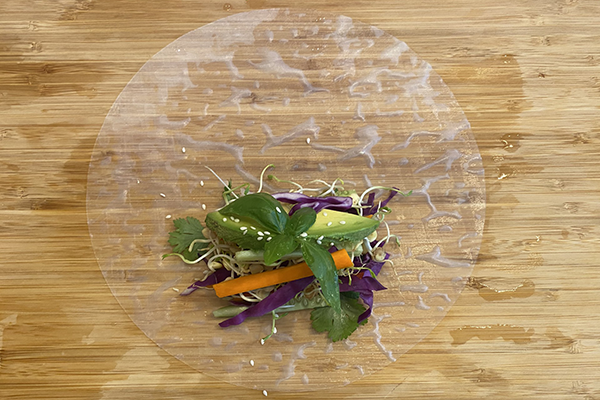
5. Gently fold in the sides of the rice paper. Then take the bottom end and gently pull it over the ingredients. Roll it up to seal.
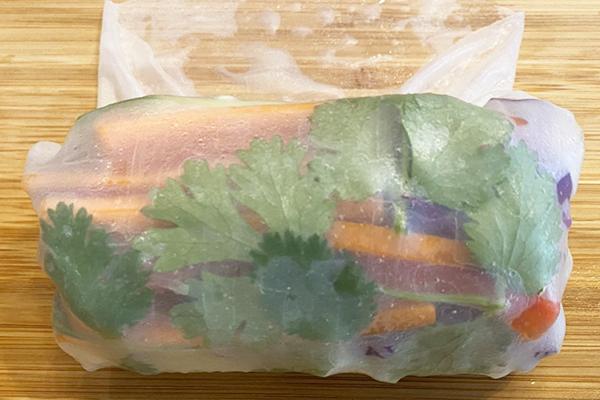
6. Repeat steps with the remaining ingredients.
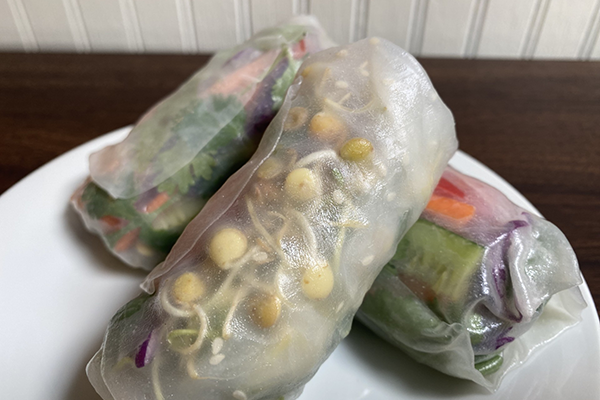
7. Serve immediately with the dipping sauce and enjoy.
NOTES
- You can substitute other nut/seed butters in place of peanut butter if needed.
- If serving summer rolls as a meal, add sliced tempeh, tofu or cooked shrimp for additional protein.
- For extra health benefits while maintaining the punch of flavor, use lactobacillus fermented carrots instead.

